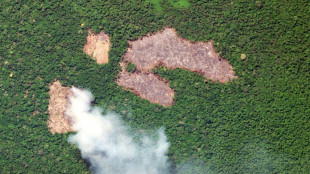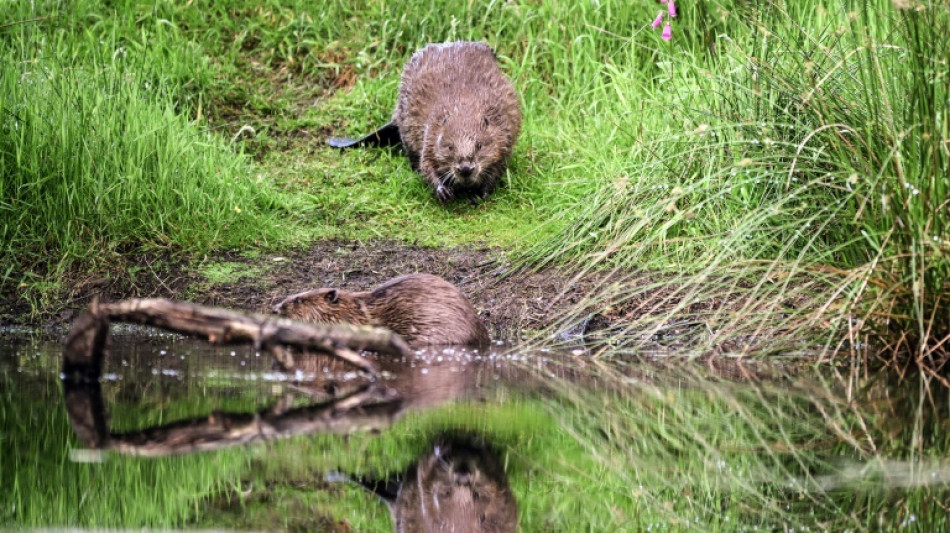
-
 US Supreme Court appears skeptical of Trump tariff legality
US Supreme Court appears skeptical of Trump tariff legality
-
AC Milan post third straight annual profit on day of San Siro purchase

-
 Angelina Jolie visits Ukrainian frontline city, media reports say
Angelina Jolie visits Ukrainian frontline city, media reports say
-
UN says forests should form key plank of COP30

-
 Star designer Rousteing quits fashion group Balmain
Star designer Rousteing quits fashion group Balmain
-
Mexico's Sheinbaum steps up cartel fight after murder of anti-narco mayor

-
 Attack on funeral in Sudan's Kordofan region kills 40: UN
Attack on funeral in Sudan's Kordofan region kills 40: UN
-
Key PSG trio set for spell on sidelines

-
 Democrats punch back in US elections - and see hope for 2026
Democrats punch back in US elections - and see hope for 2026
-
BMW reports rising profitability, shares jump

-
 Bolivia Supreme Court orders release of jailed ex-president Jeanine Anez
Bolivia Supreme Court orders release of jailed ex-president Jeanine Anez
-
Wall Street stocks rise after positive jobs data

-
 'Hostage diplomacy': longstanding Iran tactic presenting dilemma for West
'Hostage diplomacy': longstanding Iran tactic presenting dilemma for West
-
Rybakina stays perfect at WTA Finals with win over alternate Alexandrova

-
 Le Garrec welcomes Dupont help in training for Springboks showdown
Le Garrec welcomes Dupont help in training for Springboks showdown
-
Brussels wants high-speed rail linking EU capitals by 2040
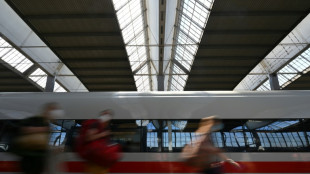
-
 Swiss business chiefs met Trump on tariffs: Bern
Swiss business chiefs met Trump on tariffs: Bern
-
Spain's exiled king recounts history, scandals in wistful memoir

-
 Wall Street stocks steady after positive jobs data
Wall Street stocks steady after positive jobs data
-
Trump blasts Democrats as government shutdown becomes longest ever

-
 Indian pilgrims find 'warm welcome' in Pakistan despite tensions
Indian pilgrims find 'warm welcome' in Pakistan despite tensions
-
Inter and AC Milan complete purchase of San Siro

-
 Swedish authorities inspect worksite conditions at steel startup Stegra
Swedish authorities inspect worksite conditions at steel startup Stegra
-
Keys withdraws from WTA Finals with illness

-
 Prince Harry says proud to be British despite new life in US
Prince Harry says proud to be British despite new life in US
-
EU strikes last-ditch deal on climate targets as COP30 looms

-
 Stocks retreat as tech bubble fears grow
Stocks retreat as tech bubble fears grow
-
Shein opens first permanent store amid heavy police presence

-
 West Indies edge New Zealand despite Santner brilliance
West Indies edge New Zealand despite Santner brilliance
-
French pair released by Iran await return home

-
 German factory orders up but outlook still muted
German factory orders up but outlook still muted
-
Death toll tops 100 as Philippines digs out after typhoon

-
 Attack on key city in Sudan's Kordofan region kills 40: UN
Attack on key city in Sudan's Kordofan region kills 40: UN
-
'No one could stop it': Sudanese describe mass rapes while fleeing El-Fasher
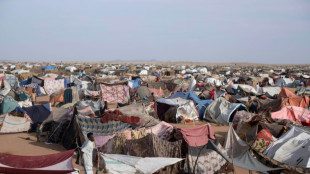
-
 Champagne and cheers across New York as Mamdani soars to victory
Champagne and cheers across New York as Mamdani soars to victory
-
Medieval tower collapse adds to Italy's workplace toll

-
 BMW boosts profitability despite China, tariff woes
BMW boosts profitability despite China, tariff woes
-
South Africa's Wiese wary of 'hurt' France before re-match

-
 Beyond limits: Croatian freediver's breathtaking record
Beyond limits: Croatian freediver's breathtaking record
-
Tottenham supporting Udogie after alleged gun threat in London

-
 Thunder roll Clippers to stay unbeaten as SGA keeps streak alive
Thunder roll Clippers to stay unbeaten as SGA keeps streak alive
-
In appeal, Australian mushroom murderer alleges 'miscarriage of justice'

-
 Toyota hikes profit forecasts 'despite US tariffs'
Toyota hikes profit forecasts 'despite US tariffs'
-
Ex-France lock Willemse challenges Meafou to become 'the bully'

-
 Ukrainians to honour sporting dead by building country they 'died for': minister
Ukrainians to honour sporting dead by building country they 'died for': minister
-
At least 7 dead after UPS cargo plane crashes near Louisville airport
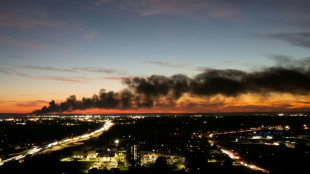
-
 US Supreme Court hears challenge to Trump tariff powers
US Supreme Court hears challenge to Trump tariff powers
-
US government shutdown becomes longest in history

-
 India's Modi readies bellwether poll in poorest state
India's Modi readies bellwether poll in poorest state
-
Green goals versus growth needs: India's climate scorecard


Scottish farmers damn wild beaver reintroduction policy
As night falls in central Scotland, beavers appear in a pond under the fascinated gaze of a group of nature enthusiasts.
Beavers are "ecosystem engineers", whose activities can alleviate flooding, improve water quality and boost wildlife.
But the visitors' delight is not shared by everyone in the region, where the industrious tree-felling mammals have caused much gnashing of teeth among farmers and gardeners.
Beavers, which had disappeared from Scotland for around 400 years due to hunting, were reintroduced in the wild in 2009.
Ten years later, to the dismay of some farmers and landowners, the herbivorous rodents were designated a protected species.
Wildlife visits to see the animals in their natural habitat are now popular and bring in revenue.
"We saw a lot of them today. I feel very privileged," said Catriona Morrison, Gaelic policy manager for Historic Environment Scotland, after a "safari" at Argaty farm, north of Stirling.
Argaty is home to endangered red squirrels as well as beavers, which can reach one metre (3.2 feet) in length and weigh up to 19 kilograms (42 pounds).
The dam-building semi-aquatic wetland dwellers were relocated there after causing serious damage to agricultural land nearby.
Argaty's owner Lynn Bower raves about them, not least because the farm track no longer floods during the winter months.
"It used to flood to a depth of about four feet (1.2 metres) and we had to rebuild it every winter," she told AFP.
"Because one of the beaver families is above that, they built dams, which holds the water back and it doesn't flood.
"They have increased the area of wetland magnificently and the benefit to the other wildlife from very small things like dragonflies and frogs, right up to bats and all those sorts of things, is staggeringly quick and rather wonderful."
- Natural engineers -
There were almost 1,000 beavers in Scotland in 2020-21, according to NatureScot, the public body responsible for Scotland's natural heritage.
Their numbers have grown because they have no natural predators in the region.
NatureScot touts beavers' role in boosting biodiversity and helping flood protection by cutting trees, digging burrows and channels, and building dams.
But, as in the case of many wildlife reintroductions, the picture is complex and not everyone is as enthusiastic.
"They're wonderful engineers but there's no place for them in Scotland," said Douglas Neill, a farmer, as he watched trucks reconstruct an embankment protecting his land from flooding from the River Tay.
The embankment collapsed in October last year because of burrows dug by the beavers, turning his potato field into a lake, he explained.
Barns that can hold up to 3,000 tonnes of vegetables lie empty, he added.
"The greens want beavers but do they think about what we are going to eat?" he asked, estimating the damage to his property at more than £2.0 million ($2.5 million).
"If we want to keep producing our own food, the solution is eradication," he said.
NatureScot says managing different interests is the key.
It offers professional support to people experiencing damage caused by beavers, with measures such as fencing vulnerable areas, protecting individual trees, "more novel techniques" or, as a last resort, lethal control of excess numbers.
- 'Beaver huggers' -
In neighbouring Perthshire, in the southern Highlands, a woman points out the dozens of trees lying felled in the woods above her house.
Beavers diverted water flowing into a ditch with their dams and build huge lodges on a pond which are now home to four families.
"When we first realised we had beavers, we thought it was fantastic. They are so sweet. We didn't realise then," she said, declining to give her name because the issue is so contentious.
She does not want to see "beaver huggers" on her land, given the damage to trees, and is at her wits end.
"We've lost so many trees... Beavers can easily destroy a tree in a night," she added.
Martin Kennedy, president of the National Farmers' Union in Scotland, wants "complete exclusion areas" to protect farm production.
NatureScot says it understands farmers' difficulties and is monitoring the beaver population to "identify how people, and ecosystems, can most benefit from the presence" of the animals.
Culling beavers is an option but only as a last resort under strict conditions, it says.
A total of 52 licences were granted in 2022 and a few dozen animals were killed.
The Scottish Government in Edinburgh, which has devolved powers over environmental policy, can move beavers elsewhere in Scotland.
They have also been moved south of the border to England.
"I feel sorry for these guys," said Neill. "They have no idea what's coming. They are going to have this in the next five to 10 years."
C.Stoecklin--VB

